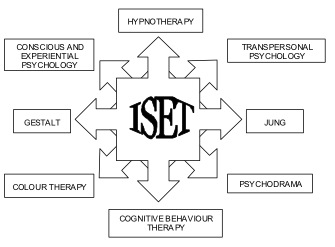What is ISET?

ISET or Integrated Self Empowerment Technique uses the language of the mind (visualisation) to change limiting belief systems and learned behaviour patterns that create illness, emotional disturbances, spiritual disharmony and life fulfillment frustrations. ISET falls within the transpersonal counselling and gestalt therapy genre of mind/body modalities.
The focus of ISET is to uncover and change the belief systems behind the behaviour, feelings and thoughts that are causing tensions in any area of life. This is based on the philosophy that with any disruptive condition or situation, the emotions, thoughts and behaviour are just indicators of the underlying unconscious beliefs about the self.
The ISET philosophical approach considers the critical incidents, feelings and thoughts to be indicators and symptoms of the belief system, not the primary focus for transformation. The belief system, assumed by the unconscious mind, is considered to be the main source of tension and therefore has greater significance when determining the approach. Changing the belief and the stored data will create a different perception so that the world is viewed through different lenses.
ISET is a proven, gentle, and safe method for creating rapid behavioural change and healing at a very deep level of consciousness.
The strength of ISET is that the power of change is in the hands of the client. The practitioner facilitates how the metaphors are structured and the process of transformation is created and achieved by the client. Because the client is actively involved in the development process, the outcome is more likely to be sustained because the client, not the practitioner, has challenged the underlying belief system.
However, there is more to ISET than just using metaphors. Its methodology has connections to several philosophical schools of thought and therapeutic approaches.
The focus of ISET is to uncover and change the belief systems behind the behaviour, feelings and thoughts that are causing tensions in any area of life. This is based on the philosophy that with any disruptive condition or situation, the emotions, thoughts and behaviour are just indicators of the underlying unconscious beliefs about the self.
The ISET philosophical approach considers the critical incidents, feelings and thoughts to be indicators and symptoms of the belief system, not the primary focus for transformation. The belief system, assumed by the unconscious mind, is considered to be the main source of tension and therefore has greater significance when determining the approach. Changing the belief and the stored data will create a different perception so that the world is viewed through different lenses.
ISET is a proven, gentle, and safe method for creating rapid behavioural change and healing at a very deep level of consciousness.
The strength of ISET is that the power of change is in the hands of the client. The practitioner facilitates how the metaphors are structured and the process of transformation is created and achieved by the client. Because the client is actively involved in the development process, the outcome is more likely to be sustained because the client, not the practitioner, has challenged the underlying belief system.
However, there is more to ISET than just using metaphors. Its methodology has connections to several philosophical schools of thought and therapeutic approaches.

ISET is holistic and to simplify its inclusive approach it:
- Utilises the skills of semantics and suggestion in an altered state of consciousness of hypnotherapy;
- Accepts the importance of experiential conditioning, culture and spiritual influences of transpersonal and experiential psychology;
- Understands the identification and recognition of behaviour’s connection to belief of cognitive behaviour therapy;
- Draws on the effectiveness of disassociation proposed by Jungian dream metaphors, gestalt dialogue and psychodrama role playing;
- Capitalises on the dynamics of the visual influence and energy of colour.
Background

ISET was originally developed by Eileen Goble in the late 1980's in Melbourne, Australia. Eileen used her background in hypnotherapy, kinesiology, and the spiritual understanding she gained from her personal experiences as outlined in her five books (Creating Wellness, Spirit Guides, Journey to Self Empowerment, A Gift from an Angel and Quest of the Spirit) to formulate the dynamic and safe healing modality.

Lynne Thorsen trained as an ISET practitioner with Eileen Goble from 1998 -2001. When Eileen became ill in 2003, she asked Lynne to be her practitioner and confidante. Just before her death in 2004, she handed the reins to Lynne and asked that she keep the ISET modality alive so that people could continue to benefit from this unique healing technique. In 2005, Lynne created 'The ISET Institute' and began running courses in Melbourne, Australia, that she devised and adapted from Eileen's original work. In 2009, when Lynne moved to France, she passed the reins to Joy Nicholson who continues to run The ISET Institute from Hobart, Australia.
ISET & CREATIVE POTENTIAL

Lynne Thorsen completed her Diploma in Source Process & Breathwork under the tutelage of its creator, Binnie A Dansby between 2010 -2013. Lynne and Binnie began writing and working together. Lynne knew that ISET and SOURCE Process & Breathwork were a perfect fit and approached Binnie with her idea for Creative Potential. The result is a unique series of personal development programs and workshops. They are primarily based on the deep inquiry processes and breathing techniques from 'Source Process & Breathwork', and include ISET inspired sessions. In addition these programs have been devised so that they can be offered online through the use of Skype, website interaction and email and are therefore available to anyone, anywhere in the world.
